READY TO GET STARTED?
REQUEST A FREE ESTIMATE
Fill out the form below or call (888) 466-7849 for a free, no-obligation estimate.
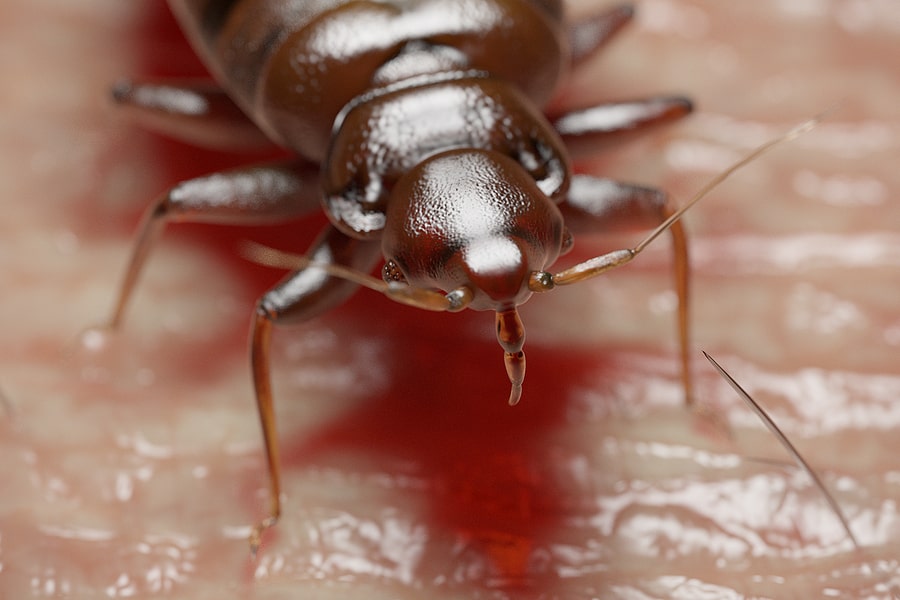
Traveling can be stressful. The last thing anyone wants to deal with on top of the routine stress of traveling is bed bugs. These pests are notorious hitchhikers and often catch rides with travelers on their luggage to move from place to place. How can you eliminate the potential for bed bugs while traveling? Here is our traveler’s guide to bed bugs to help make your trip as smooth and bed bug free as possible.
Properly identifying bed bugs is the first step to preventing an infestation. There are other common bugs that are often mistaken for bed bugs like carpet beetles, spider beetles, bat bugs, booklice, and fleas. Bed bugs are small, about 3/16″ to 1/4″ in length (about the size of an apple seed). If they have not fed recently, they are long and brown with a flat, oval-shaped body. If they have recently had a meal, they will be balloon-like and elongated with a reddish-brown color. They are “true bugs” with a 3-segmented beak, antenna with 4 parts, wings that aren’t used for flying, and short, golden-colored hairs. They also have an odor which is often described as sweetish or musty. Bed bug nymphs are smaller, translucent, and whitish-yellow in color. Bed bug eggs are tiny, about the size of a pinhead and are pearl white in color.
The next step in bed bug prevention is recognizing the signs of the presence of bed bugs. You should look for signs of bed bugs any time you are cleaning, changing bed linens, or inspecting the area where you are staying on a trip. Signs of bed bugs include rusty, reddish-brown stains on the bed sheets or mattress that happen when bed bugs are crushed; dark spots about the size of a period that are bed bug excrement that bleeds onto bed linens; eggs and eggshells that are tiny (about 1 mm in size); pale yellow skins that are shed by the nymphs; and live bed bugs. Any of these signs indicate the presence of bed bugs.
Bed bugs are tiny pests that can fit into a crack or crevice the size of a credit card. Knowing where bed bugs can hide is the next step to avoiding them. When checking for bed bugs, thoroughly inspect the piping, seams, and tags of mattresses and box springs; cracks in the bed frame and headboard; seams of chairs and couches; between cushions; in the folds of curtains; in drawer joints; in electrical receptacles and appliances; under loose wallpaper and wall hangings; where the wall and the ceiling meet; along baseboard seams and cracks; and in the head of screws.
Knowing how bed bugs act is essential to finding, eliminating, and preventing them. Bed bugs prefer to feed on humans but will also feed on other mammals and even birds. They will travel anywhere from 5 to 20 feet from their hiding spots to feed on a host. They are primarily nocturnal but will seek a host during daylight in larger infestations. They will feed on a host anywhere from 3 to 12 minutes. Bed bugs need at least 1 blood meal to be able to develop into the next stage of their life cycle. In order to continue to mate and produce eggs, both male and female bed bugs must feed at least once every 14 days. Females lay anywhere from 1 to 3 eggs per day and 200 to 500 eggs in their lifetime. They can survive temperatures as low as 46 degrees Fahrenheit but will die when their body temperature reaches 113 degrees Fahrenheit; hence the use of heat in bed bug treatments. Bed bugs can be found anywhere their hosts can be found.
Now that you know what bed bugs look like, where to find them, and how they act, the final step is how to prevent them. This is especially important when you are traveling. The first step is to check the bed bug registry to make sure the place you are staying doesn’t have any recently reported cases of bed bugs. Anytime you are staying outside your home, inspect the room where you are staying thoroughly for the presence of bed bugs. Use a flashlight and pull the sheet back to get a closer look. Inspect all of the areas listed above where bed bugs can hide. Use luggage racks to store your suitcases and bags and try to avoid putting them on the bed or the floor. Keep your belongings stored separately from those of the others you may be staying with. Consider storing your luggage in trash bags or protective coverings during your stay. If you find signs of bed bugs where you are staying, request to change rooms. If you must change rooms, do not move into a room that is adjacent to or directly above or below the infested room. When you return home from your trip, unpack your luggage directly into your washing machine and wash and dry everything on high heat. Inspect your luggage for bed bugs and use a vacuum or hand steamer to clean it before storing it. Keep luggage stored away from your bedroom, possibly in the basement or garage. Never store luggage under your bed.
With this traveler’s guide to bed bugs you will be well equipped for your next trip. If you suspect you have a bed bug infestation, contact a professional pest control company who can provide a thorough inspection and bed bug control service.
What You Should Know About Flies!
The Essentials of Crawlspace Moisture Barriers
I’ve Taken Precautions, But I’m Still Seeing Roaches!
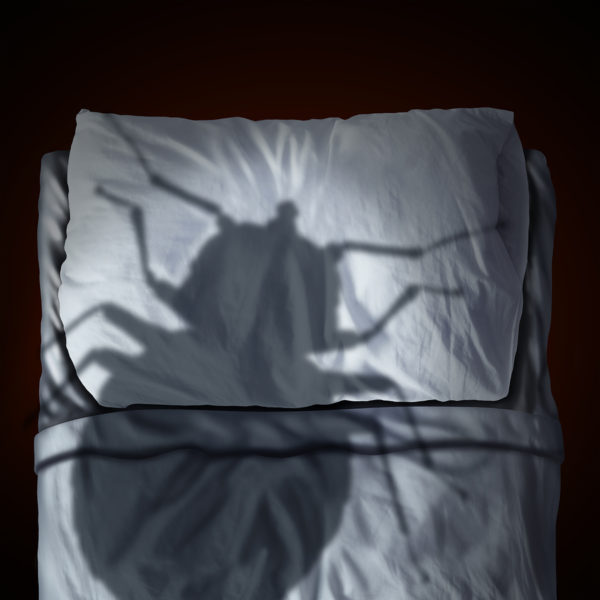
For many of us, the holiday season is a time of joy. It is also a time for travel as we look forward to spending time with family and friends. One thing that can damper our holiday season is dealing with unwanted visitors – no, not that cranky Scrooge of a relative – but bed bugs! Bed bugs are notorious hitchhikers, tagging along with unsuspecting travelers on their clothes and luggage. As we enter the biggest travel season of the year, check out these tips for preventing bed bugs and preserving your holiday cheer.
When you have guests staying with you, make sure you are prepared for the possibility of bed bugs being brought in with them. Don’t put your guests’ coats and bags on the bed. Instead, clean out a closet and use it to store their belongings. If you have to put their items on the bed, lay a sheet down first. It can be cleaned later. Place a plastic mat by the door for them to place their shoes on. If possible, provide luggage racks for them to use to store their belongings on. Use a bed bug mattress cover on any beds your guests will be using. If your guests will be sleeping on the couch, lay a sheet down over it first.
Once your guests leave, make sure to go behind anywhere they kept coats or luggage and clean. Vacuum closets where luggage and coats were kept. Vacuum the beds and couches where they slept. Seal the vacuum bags immediately and dispose of them outside. If you used sheets under luggage or on your couches, wash them in hot water and dry them on high heat. Wash the plastic mat you used for their shoes with hot, soapy water.
Whether you have guests who just left or you are the guest yourself, check your surroundings for signs of bed bugs. Inspect the mattress, box springs, and headboard, especially around edges and seams. Make sure to check couch cushions and chairs, as well. The most common sign of bed bugs is small, rust colored spots. Avoid using dresser drawers if possible. When you arrive at your destination, especially if you have been in a heavily populated area (subway, bus, airport, etc) check your shoes, jackets, hats, and luggage immediately. Be sure to check around zippers and seams. If you spot bed bugs, remove the clothing immediately and wash in hot water and dry on high heat. Vacuum luggage and seal and dispose of the vacuum bag immediately. If you are going to be a guest at a hotel or other lodging accommodation, you can also check the Bed Bug Registry, which is a free user-submitted database of bed bug reports across the US and Canada.
Once you arrive home from your travels, unpack your luggage and change your clothes immediately. Wash everything in hot water and dry on high heat. The heat of the water and air from the dryer will kill any bed bugs that may be lingering around. Once unpacked, vacuum or steam your luggage and seal it in plastic bags or containers. Store your luggage outside the home (in a garage, shed, etc) until you need to use them again.
Bed bugs are resilient and can be extremely difficult to get rid of. If you suspect you have a bed bug problem, call a pest control professional who can come in and provide you with a thorough evaluation and comprehensive treatment plan.
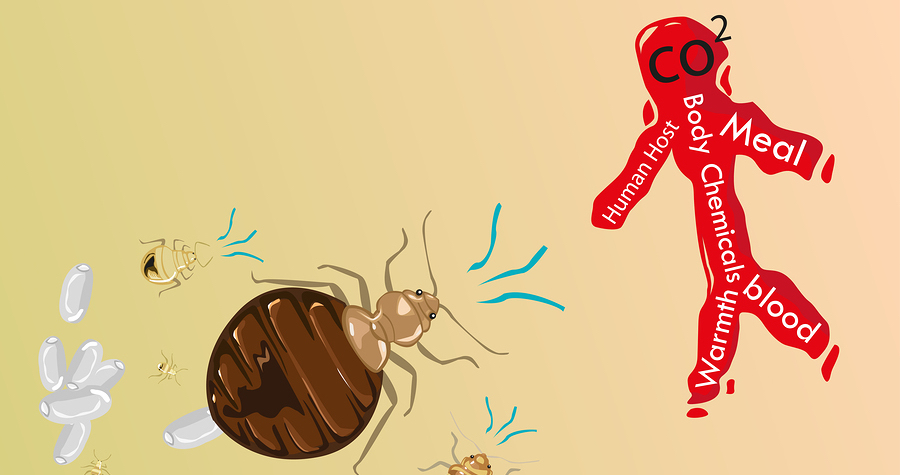
Bed bugs are an ongoing problem in the pest industry with no foreseeable changes in the near future. Infestation cases are on the rise and will most likely increase with the upcoming holiday season. So as your family makes plans for traveling, relatives visiting, and students coming home from college, it’s important to know how to keep your home protected from the ultimate hitchhiker: the bed bug.
If you’ve never seen a bed bug, you may have a hard time finding or identifying one. Keep reading to find out what bed bugs look like, where to find them, what threats they pose, and how to prevent and control them.
Red to brown in color (red after they’ve had a blood meal), six legs, flat and oval in shape, about 1/4″ in size or smaller
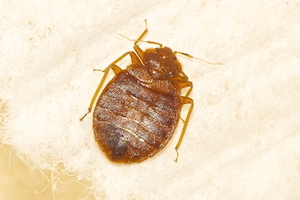
Cracks and crevices close to a human food source – behind baseboards, in furniture, bed frames, mattresses & boxsprings, suitcases, boxes (like shoe boxes or under bed storage), behind electrical switch plates
Bed bugs are excellent travelers and often go unnoticed since they’re nocturnal. They typically appear at night once you’re sleeping to feed and often leave behind red, itchy welts on the skin when bitten. Although they don’t transmit diseases, bed bugs are extremely elusive and hard to get rid of once an infestation occurs and can’t be eradicated with do-it-yourself treatments.
Don’t bring suitcases inside your home after traveling. Remove all clothes first, wash them, and run through a high heat dryer cycle. Bed bugs cannot withstand high temperatures so this ensures you’re killing any that may have travelled back with you from trips, relatives’ homes, school, etc. Vacuum suitcases and leave them somewhere outside your home, preferably in sealed bags or containers, until you need them again. Also, make a habit of inspecting your bed for signs. Dark (blood) spots on sheets, pillows or other bedding is the most obvious indicator of a bed bug infestation. If you’re seeing this, call an exterminator immediately that specialized in bed bug treatment and control.
Because of the elusive nature of bed bugs and their ability to survive in extreme conditions (bed bugs can live for a year or more without eating and can withstand a wide range of temperatures from nearly freezing to 113 degrees Fahrenheit), they can’t be eliminated through do-it-yourself methods. If you’ve identified a bed bug infestation in your home or business, or suspect bed bug activity, call a professional pest control company. A proper inspection is needed to identify all areas of infestation. After an in-depth inspection, a treatment and control plan can be implemented, usually including multiple chemical and/or heat treatments and inspections over several weeks. As part of the treatment plan, you may be asked by your exterminator to remove or reduce clutter, install protective encasements to your mattresses and/or boxsprings, and launder bedding and/or clothing. You should also be advised not to throw out any infested furniture, clothes or other items; this can cause the spread of bed bugs to other locations. It’s also not recommended to purchase new furniture throughout the treatment process as these items will likely become infested with bed bugs.
For more on Bed Bug Treatments in your area, click on the links below

Bed bugs are an ongoing problem in the pest industry with no foreseeable changes in the near future. Infestation cases are on the rise and will most likely increase with the upcoming holiday season. So as your family makes plans for traveling, relatives visiting, and students coming home from college, it’s important to know how to keep your home protected from the ultimate hitchhiker: the bed bug.
If you’ve never seen a bed bug, you may have a hard time finding or identifying one. Keep reading to find out what bed bugs look like, where to find them, what threats they pose, and how to prevent and control them.
Red to brown in color (red after they’ve had a blood meal), six legs, flat and oval in shape, about 1/4″ in size or smaller

Cracks and crevices close to a human food source – behind baseboards, in furniture, bed frames, mattresses & boxsprings, suitcases, boxes (like shoe boxes or under bed storage), behind electrical switch plates
Bed bugs are excellent travelers and often go unnoticed since they’re nocturnal. They typically appear at night once you’re sleeping to feed and often leave behind red, itchy welts on the skin when bitten. Although they don’t transmit diseases, bed bugs are extremely elusive and hard to get rid of once an infestation occurs and can’t be eradicated with do-it-yourself treatments.
Don’t bring suitcases inside your home after traveling. Remove all clothes first, wash them, and run through a high heat dryer cycle. Bed bugs cannot withstand high temperatures so this ensures you’re killing any that may have travelled back with you from trips, relatives’ homes, school, etc. Vacuum suitcases and leave them somewhere outside your home, preferably in sealed bags or containers, until you need them again. Also, make a habit of inspecting your bed for signs. Dark (blood) spots on sheets, pillows or other bedding is the most obvious indicator of a bed bug infestation. If you’re seeing this, call an exterminator immediately that specialized in bed bug treatment and control.
Because of the elusive nature of bed bugs and their ability to survive in extreme conditions (bed bugs can live for a year or more without eating and can withstand a wide range of temperatures from nearly freezing to 113 degrees Fahrenheit), they can’t be eliminated through do-it-yourself methods. If you’ve identified a bed bug infestation in your home or business, or suspect bed bug activity, call a professional pest control company. A proper inspection is needed to identify all areas of infestation. After an in-depth inspection, a treatment and control plan can be implemented, usually including multiple chemical and/or heat treatments and inspections over several weeks. As part of the treatment plan, you may be asked by your exterminator to remove or reduce clutter, install protective encasements to your mattresses and/or boxsprings, and launder bedding and/or clothing. You should also be advised not to throw out any infested furniture, clothes or other items; this can cause the spread of bed bugs to other locations. It’s also not recommended to purchase new furniture throughout the treatment process as these items will likely become infested with bed bugs.
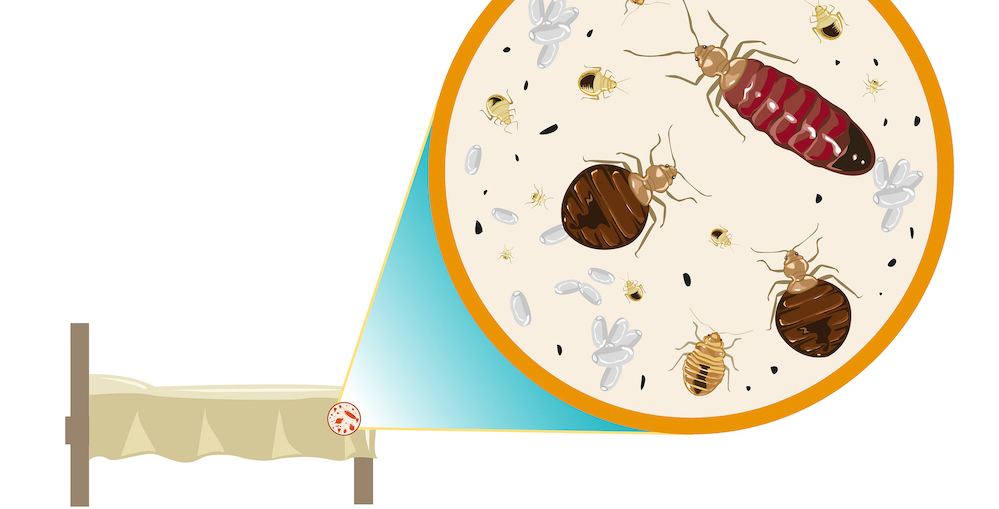
We talk a lot about how NOT to get bed bugs. By now you know to take precautions when traveling – ask hotels before booking if they’ve had a history with bed bugs, check for signs of bed bugs after check in (around mattress edges most common), and don’t leave luggage or clothing sitting on beds that aren’t your own. You also know it’s not a great idea to bring your luggage into your home right after a trip. Instead, leave in your garage and wash all the clothing before bringing inside, if possible. Store suitcases in an outdoor closet if available. Even if you’ve done all of the above, bed bugs are great travelers and CAN find their way into your home – maybe in that second-hand piece of furniture you recently purchased, from overnight house guests’ luggage, or even your kids returning home from college with a few extra “friends”. Bed bugs are made to survive in the most extreme conditions, making it hard to get rid of them once they’re in your home.
Finding and identifying bed bugs doesn’t have to be hard, though. Typically they like to live only a few feet away from their food source – any living person or pet in your home. So most likely you’ll find them in and around your bed. So how will you know when you have bed bugs? The most obvious sign is bites. You may see them on your skin or experience itchiness. Or you may not feel or see bites at all. In this case, bed bug infestations can worsen since you don’t know they’re there until it’s too late. To avoid this, check for bed bugs often. When changing bedding, check for signs – dark spots (fecal matter) on mattresses, box springs, pillows, on bed skirts, and headboards. You may also see bed bugs if you’re heavily infested, in any of their life stages – from eggs to nymphs to adults. In the adult stage, bed bugs are relatively flat, small, round, and a reddish brown color (this coloring is darker after a feeding). You can see the different life stages of bed bugs in the photo below.
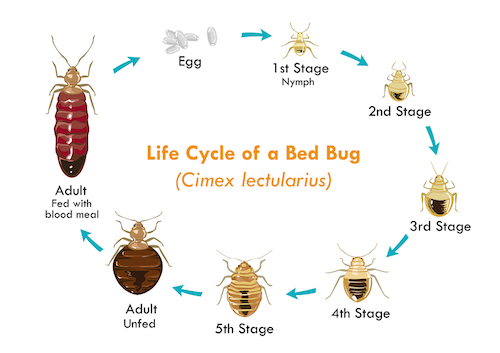
So now what? While it may be hard to stomach, continue sleeping in your bed until the bed bugs have been eliminated. Moving to other areas of your home, such as a guest bedroom or the sofa, could cause the bed bugs to travel with you and infest other areas. If you want to change your bedding, wash everything in hot water. Bed Bugs can’t survive in extremely hot conditions so this will kill any hiding out in pillows, comforters, etc. While some exterminators may suggest otherwise, it’s usually best to leave everything else as is until you’ve had a professional inspection. Again, you don’t want the bed bugs to migrate to other areas of the house.
Next, call a pest control company that specializes in bed bug treatments. There are several methods of treatment available and an experienced exterminator will know which solution is best for your situation. This will also ensure you’ve correctly identified bed bugs. In the meantime, while waiting for your inspection, resist the urge to throw beds, bedding and furniture out. This will only worsen the infestation, since they could be in areas of your home you’re unaware of, therefore will infest any new items your purchase. And you also risk spreading the pests to others, by leaving infested furniture untreated.